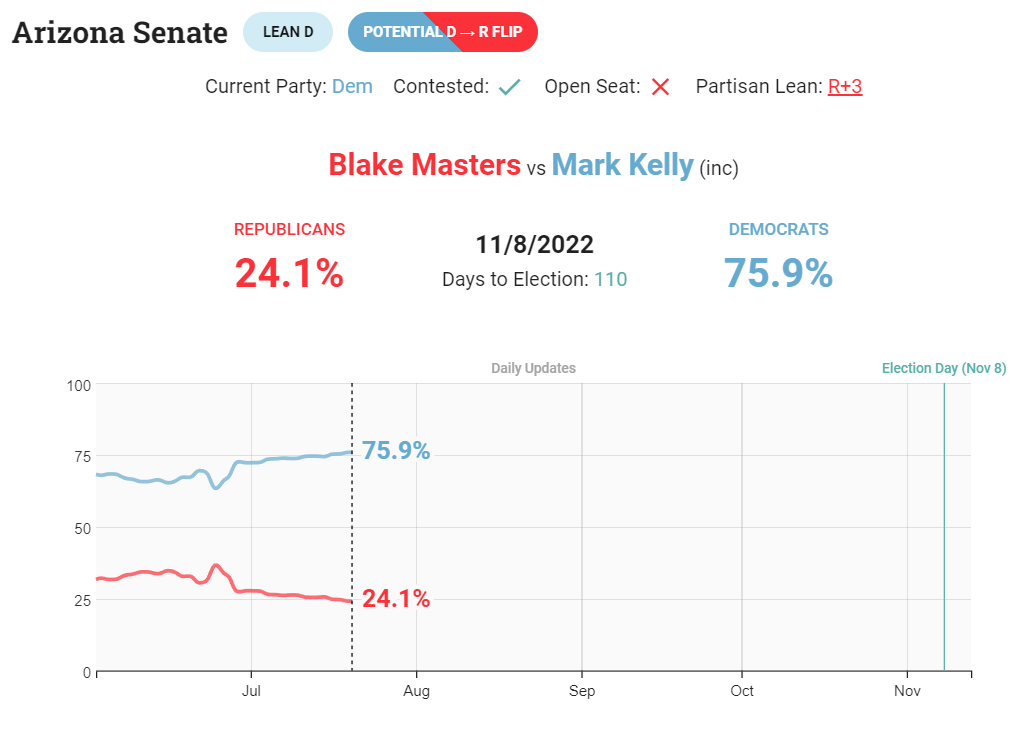Since we launched our 2022 forecast model yesterday, we’ve received a lot of interest, great feedback, and some less than great feedback. You have to take the good with the bad and we’re happy to be part of the conversation of an engaged election audience. If you haven’t already, check out our model release video with Professor of Data Science Liberty Vittert. She’ll be providing context for each of our releases and sharing her expertise as the campaign unfolds.
We want to take a minute to highlight a couple of the most common questions and feedback points people have brought up.
First, no matter what anyone running for office claims, our model does not project outcomes of primaries that have yet to be held. We simply have to have a candidate for both parties in each race and we use ones with legitimate chances of winning. For example, it makes no difference to our model if the GOP candidate in the Missouri Senate race is Attorney General Eric Schmitt or Eric Greitens who resigned as Governor under a cloud of ethical concerns. Missouri is fundamentally a Republican state, more on that below.
It should also go without saying, a forecast project is not the same as an election night race call. Our forecasts are designed to provide information to help understand the current political environment and they will change as the environment changes.
A couple of our forecasts in particular have generated a good bit of attention and we’d like to share why the model came out the way it did.
First is the Wisconsin Senate rating of Solid R. There are a number of factors that lead to that rating. While the Democratic candidate, assumed for our purposes at this point to be Lt. Governor Mandela Barnes, has a slight polling lead in the DDHQ Polling Average (+2), But other factors matter as well:
- Incumbency and the fact Johnson beat Russ Feingold twice.
- The general political environment is expected to be more favorable to Republicans than even 2016.
- Wisconsin’s move to the right relative to the nation in recent elections, fundraising, and other variables strongly favor Senator Ron Johnson’s reelection at this point.
- Republicans won the House popular vote in Wisconsin by over 3 points in 2020 (all eight races were contested), a slightly blue-leaning year, with Republicans Bryan Steil and Mike Gallagher outpacing Trump by over 10 points in their respective districts.
- Wisconsin’s demographics (low minority population, low percentage college-educated) are in line with many of the reddest states in the country. Although demographics only have a minimal weighting in our model, they are a major reason why our fundamentals prediction for Wisconsin is more Republican than in Florida.
- Johnson +11 is a reasonable prediction given all of the above facts and model assumptions. This does not rule out a Democratic win by any means, but the fundamentals very strongly favor Ron Johnson to win a third term.

Something else to consider, when translating quantitative measurements to qualitative labels, there’s always a cutoff point. Johnson is at 95.5% making it a Solid rating. The cutoff of point between Solid and Likely is 95%, so a movement towards the Democrats of just a few tenths of a point would mean a change in the qualitative label.
The second race that has drawn attention is Arizona Senate with people asking why Democrat Mark Kelly is rated as having a greater chance to win compared to other incumbent Democrats who are considered vulnerable.
Many of the same factors are at play for Kelly as they are for Johnson. Right now the fundamentals of races are the most important factors being weighted. Fundraising is an area where Kelly enjoys an enormous advantage. His $25 million Cash on Hand out paces potential GOP nominee Blake Masters’ $1.6 million. Masters still has just under two weeks to go in his primary campaign.

All of this may change as more polls are added to the mix, there are only two at this point in Arizona and the state of the overall environment comes into focus the closer we get to election day.
We hope this helps you to understand why our model is making these predictions and we appreciate your interest.